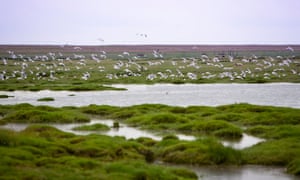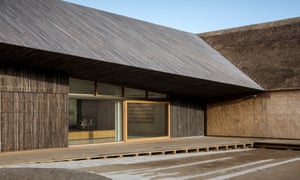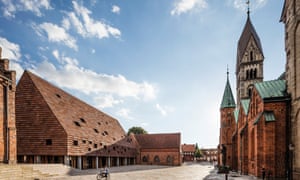https://www.theguardian.com/travel/2017/jul/11/marshes-mud-flats-and-migrating-birds-on-denmarks-wadden-sea
Eastwards, the view feels like it goes on for a thousand miles. It must be 15km or maybe 20. Looking west, the sight lines are just as flat, though here the low-lying vistas are marshy, with rivulets snaking their way across the flat sands to the North Sea proper, several kilometres further downstream. In a country that has barely a hill to its name, south-west Jutland is Denmark at its flattest.
The Wadden Sea, running from the northern Netherlands across Germany’s north coast and up Denmark’s west coast past the city of Esbjerg, is one of the world’s largest and Europe’s longest continuous stretch of wetlands. The Danish stretch of these panoramic mud flats, long curving tidal creeks, and mile upon mile of soft sand beaches, was awarded Unesco world heritage status in 2014, after being declared a national park (the country’s largest) in 2008.
A low-slung visitor centre, reopened this year near the ancient town of Ribe, is a striking addition to the region’s tourist draws. Designed by Dorte Mandrup, Denmark’s top female architect, it’s all sharp angled lines that are all the more surprising when you realise they’re made from one of the oldest building materials in the world, thatch.
Thatch is cool these days, having returned to favour across Europe’s sustainable architecture scene. Chosen so the building sits and indeed becomes part of the landscape and its flatland surroundings, it’s also an obvious nod to the marshy borders, as well as local rural building tradition. The centre is already proving popular, notching up 30,000 visitors in its first three months. Inside, a beautiful display successfully mixes old-school exhibits – watercolour bird paintings for example – with new media interactivity.
The wetlands are a unique and rich ecological habitat, home to diverse flora and fauna, with any number of delicacies living in the mudflats for hungry migratory birds on along what is delightfully known as the East Atlantic Flyover.
Not surprisingly, the area is a twitchers’ paradise: up to 12 million geese, waders, ducks and other migrating birds touch down during their epic migratory flights between Arctic sites such as Greenland’s Disko Bay and, thousands of miles south, West African winter resting grounds. And these are not the only avian wonders; each spring and autumn the skies around and above this corner of Jutland come alive with the balletic displays of tens of thousands of starlings, murmurations known locally as the Black Sun.
The region doesn’t only attract bird-watchers, though. It has long been a favoured holiday destination for Danes, other Scandi nations and, particularly, Germans. Despite its reputation for being one of the windiest and rainiest parts of northern Europe, the summer comes with its share of hot, sunny days to enjoy in one of the area’s many holiday cottages. (UK tourist nunbers have dipped since a ferry services between Esbjerg and Harwich ended in 2014.)
Those who make the journey there will discover a Denmark several gears slower than the more obvious go to’s, Copenhagen, or Denmark’s second city, Aarhus, one of this year’s European capitals of culture.
All along West Jutland’s coastland the towns, villages, and countryside tick to a different pace. Esbjerg, once the heart of the South Jutland fishing industry, is the exception, still an industrial hub exporting Vestas wind turbines around the world. By contrast, Ribe, a half-hour journey south, has a peaceful, time-warp ambience.
Ribe (pop 8,000) is Denmark’s – and indeed Scandinavia’s – oldest town, a postcard-perfect picture of tranquility and atmospheric historic buildings. A 13th-century cathedral sits on the recently restored town square, amid a tapestry of red brick buildings that include two more firsts, Denmark’s oldest town hall and hotel, Hotel Dagmar.
I made my way down the main street, Overdammen, a honeypot of shops and restaurants, before dipping into a fishing museum close to the river Ribe, filled to the gills with exhibits from the bygone fishing era.
Not surprisingly, given this is Denmark, cycle routes criss-crossing the town into the flatlands: one runs along river, past the town’s well placed youth hostel. The coast and visitor centre can be reached by bus, bike or on foot, and there are several campsites in the countryside nearby. Those who’ve come searching for their inner Viking, can head to Ribe Viking Museum in town, and, a couple of kilometres south in Lustrup, the VikingeCenter, where you can commune with characters in full Viking garb, living the dream.
A causeway leads out to Mandø, one of several sand islands, which sit pancake flat and just about above sea-level amid the mudflats. The road is only passable at low-tide, and a tractor-bus trundles out from near the visitor centre. All of 60 people live mainly on seaward side of the island, close to one of the Wadden Sea’s sandier beaches. Another island, Rømø, further south, has wide sandy beach along its entire western edge.
Oysters, unsurprisingly, are a Wadden Sea delicacy, and at Mandø visitors can try them served with champagne on a horse-drawn carriage as it makes its way from the mainland. Seal watching is also popular. The visitor centre runs all-day mud hikes and “oyster safaris”. Those wanting to head out alone are strongly advised to check the tide times.
Cyclists could head south to the German border, about 50km away, or north to where the Wadden Sea ends at Ho Bay. However, the joined-up thinking that created the international Unesco listing hasn’t begun to consider connecting cycle infrastructure to the various visitor stopovers. Folks there say that is coming. In the meantime, the visitor centre is quite a stop-gap, thatch and all.
Since you’re here …
… we have a small favour to ask. More people are reading the Guardian than ever but advertising revenues across the media are falling fast. And unlike many news organisations, we haven’t put up a paywall – we want to keep our journalism as open as we can. So you can see why we need to ask for your help. The Guardian’s independent, investigative journalism takes a lot of time, money and hard work to produce. But we do it because we believe our perspective matters – because it might well be your perspective, too.
I appreciate there not being a paywall: it is more democratic for the media to be available for all and not a commodity to be purchased by a few. I’m happy to make a contribution so others with less means still have access to information.Thomasine F-R.
If everyone who reads our reporting, who likes it, helps to support it, our future would be much more secure.






沒有留言:
張貼留言